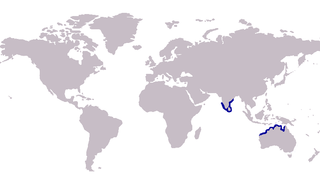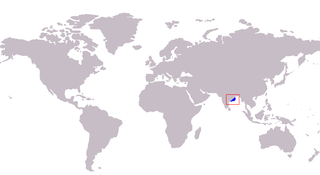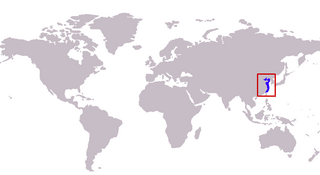
The Sillaginidae, commonly known as the smelt-whitings, whitings, sillaginids, sand borers and sand-smelts, are a family of benthic coastal marine fish historically classified in the order Perciformes, although the 5th edition of Fishes of the World places the family in the Spariformes. The smelt-whitings inhabit a wide region covering much of the Indo-Pacific, from the west coast of Africa east to Japan and south to Australia. The family comprises only five genera and 35 species, of which a number are dubious, with the last major revision of the family in 1992 unable to confirm the validity of a number of species. They are elongated, slightly compressed fish, often light brown to silver in colour, with a variety of markings and patterns on their upper bodies. The Sillaginidae are not related to a number of fishes commonly called 'whiting' in the Northern Hemisphere, including the fish originally called whiting, Merlangius merlangus.

The King George whiting, also known as the spotted whiting or spotted sillago, is a coastal marine fish of the smelt-whitings family Sillaginidae. The King George whiting is endemic to Australia, inhabiting the south coast of the country from Jurien Bay, Western Australia to Botany Bay, New South Wales in the east. The King George whiting is the only member of the genus Sillaginodes and the largest member of the smelt-whiting family Sillaginidae, growing to a length of 80 cm and 4.8 kg in weight. The species is readily distinguishable from other Australian whitings by its unique pattern of spots, as well as its highly elongate shape. King George whiting are often found in bays and protected waterways over sand and seagrass beds, also venturing out onto deep continental shelf reefs during adulthood. The species is a benthic carnivore, consuming a variety of crustaceans, polychaete worms, molluscs and fish. The King George whiting forms the basis of one of southern Australia's most important commercial fisheries, reportedly worth over five million Australian dollars per year. The species is also heavily targeted by recreational anglers, who value the whiting for its sporting and eating qualities.

The oriental trumpeter whiting is a widely distributed species of benthic inshore fish in the smelt-whiting family. The species ranges from east Africa to Japan, inhabiting much if the southern Asian and Indonesian coastlines. Its morphology is very similar to other species within the genus Sillago, with a long, compressed body and silvery overall colour. It can be distinguished from its relatives by colour patterns and particularly swim bladder morphology, which helps define most species of Sillago. S aeolus is a benthic predator, consuming a variety of crustaceans and polychaetes. As with most members of the smelt whiting family, it is important to small coastal fisheries in various areas of its range.

The Asian whiting is a species inshore marine fish in the smelt whiting family, Sillaginidae, distributed along the Asian coastline from the Gulf of Thailand to Taiwan. The Asian whiting's appearance is very similar to other closely related species in the genus Sillago, with swim bladder morphology and ray counts of fins the most reliable identifying features. The species inhabits slightly deeper water than many of the sillaginid species its distribution overlaps, forming an important part of the whiting fishery in the countries within its range.

Boutan's whiting is a poorly understood species of coastal marine fish of the smelt-whiting family Sillaginidae that inhabits the waters of the Gulf of Tonkin and south eastern China. Like most sillaginids, the species inhabits areas populated with a number of other whiting species of similar appearance, causing the species to often be misidentified as the well known Sillago sihama, and for this reason its biology is poorly known. The species is taken by seine net in Vietnam and is often exported to Japan.

The Indian whiting is a poorly known species of coastal marine fish of the smelt-whiting family Sillaginidae. The species was named in 1985, having previously being misidentified as another species of Sillago, S. parvisquamis. The Indian whiting inhabits the east and west coasts of the Indian subcontinent, apparently not extending to the southern tip of India. Like all sillaginids, it is benthic in nature, living in depths to 30 m where it is caught by fishermen alongside other species of Sillago.

The bay whiting is a species of coastal marine fish of the smelt-whiting family, Sillaginidae. The bay whiting's range extends throughout the west Indian Ocean, including northern Australia, Thailand, India and Taiwan, where it inhabits protected waters. It is benthic in nature, preying on shrimps, polychaetes and molluscs, however little else is known of its biology. Bay whiting are an important part of some inshore fisheries around Australia and Asia, where subsistence and commercial fishermen regularly take the species.

The Intermediate whiting, is a species of coastal marine fish of the smelt-whiting family Sillaginidae. The intermediate whiting ranges from the west coast of India to the Gulf of Thailand in the east, inhabiting silty substrates in shallow waters. First identified in 1977 from a specimen found in a fish market, the species has had little research performed on its biology, and is frequently misidentified as Sillago sihama or Sillago maculata intermediate whiting are commonly caught by fishermen throughout their range and are marketed fresh locally.

The mud whiting, or mud sillago, is a species of coastal marine fish in the smelt-whiting family Sillaginidae. The mud whiting was first described in 1985 and is currently known from the north west coast of Australia and the Indian coast.

The large-scale whiting the only member of the genus Sillaginops, is a poorly understood species of coastal marine fish of the smelt- whiting family Sillaginidae. First described in 1859, the large-scale whiting is known to inhabit shallow waters along the coasts of a number of Indo-Pacific countries including Japan, Indonesia, Philippines and the Solomon Islands. Little is known of the species biology, even though it is of minor importance to fisheries throughout its range.

The large-headed whiting is a dubious species of coastal marine fish in the smelt-whiting family that has only been recorded from one specimen captured off the coast of China in 1933. Although very similar to Sillago sihama, the species is characterised by an unusually large head which accounts for 33% of the total body length.

The small-eyed whiting is a poorly known species of coastal marine fish of the smelt-whiting family Sillaginidae. The species is known from only two specimens; the holotype collected by Roland McKay in 1985 from a Taipei market, both specimens of which were taken from the waters of Taiwan. Apart from a relatively small eye size, the species is hard to distinguish from other common species of sillaginid taken in the area, and may be a minor part of local fisheries.

The northern whiting, also known as the silver whiting and sand smelt, is a marine fish, the most widespread and abundant member of the smelt-whiting family Sillaginidae. The northern whiting was the first species of sillaginid scientifically described and is therefore the type species of both the family Sillaginidae and the genus Sillago. The species is distributed in the Indo-Pacific region from South Africa in the west to Japan and Indonesia in the east. The northern whiting inhabits coastal areas to 60 m, but is most often found in shallow water around bays and estuaries, often entering freshwater. It is a carnivore, taking a variety of polychaetes and crustaceans. The species is of major economic importance throughout the Indo-Pacific. It is most frequently taken by seine nets and cast nets and marketed fresh.

The small-scale whiting, also known as the blue whiting, is a species of inshore marine fish of the smelt-whiting family Sillaginidae. The small-scale whiting is very similar in body shape and colour to other species in the genus Sillago, but is distinguished by having 12 or 13 spines in the first dorsal fin compared to 11 in all other species. The species is distributed through parts of the west Pacific Ocean including Japan, Taiwan, Korea and India, inhabiting the tidal flats of major estuaries. It is a benthic predator taking crustaceans, molluscs and annelids. Spawning in the species takes place from May to September, with peaks identified in June and July. The eggs and larvae have been extensively studied in order to distinguish them from the more abundant Sillago sihama. Minor fisheries exist for the small-scale whiting, although it is thought be endangered by habitat loss and pollutionIUCN.

The soringa whiting, also known simply as soringa or soringa sillago, is a poorly known species of coastal marine fish of the smelt-whiting family, Sillaginidae. The Soringa whiting is known exclusively from the east coast of India, inhabiting shallow inshore environments, particularly sandy substrates. S. soringa was first described in 1982 by Dutt and Sujatha, with the taxonomic status of the species was questioned by Roland McKay in his review of the Sillaginidae, with similar features to S. asiatica suggesting it is a senior synonym of the latter.

The estuarine whiting, also known as Vincent's whiting, is a species of benthic inshore marine fish of the smelt-whiting family, Sillaginidae. The estuarine whiting is very similar in appearance to the northern whiting, Sillago sihama, and as such was mistaken for the latter until 1980, when R.J. McKay identified the species based primarily on swimbladder morphology. The estuarine whiting is distributed along both the east and west coasts of India, primarily inhabiting the muddy substrates of estuaries. The species is locally important to fisheries in India, and is recognized as having aquaculture potential.

The Chinese sillago is a species of inshore marine fish in the smelt whiting family Sillaginidae, described in 2011. The species is known only to inhabit the coastal waters of China, primarily in estuarine tidal flats near Wenzhou, Zhejiang Province. The Chinese sillago was described in 2011 based on morphological and DNA barcode analysis of several specimens. Several detailed anatomic features distinguish it from other sillaginids, with Sillago parvisquamis its closest relative based on phylogenetic analysis. Nothing is known of the ecology or importance to fisheries of the Chinese sillago.
Sillago caudicula is a species of marine fish in the smelt-whiting family Sillaginidae. It is found in Oman in the western Indian Ocean. This species reaches a length of 14.9 cm (5.9 in).
Sillago shaoi is a species of marine fish in the smelt-whiting family Sillaginidae. It is found in Western Pacific, from the Taiwan Strait between Taiwan and China.

The black-banded sillago is a species of marine ray-finned fish belonging to the family Sillaginidae, the smelt-whitings or sillagos. This species is found in the western Pacific Ocean.


















